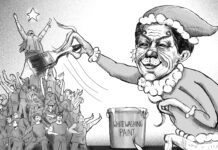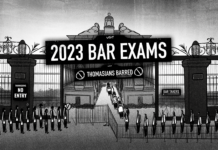THE BELEN gives us an idealized image of the first Christmas that happened two millennia ago. We see a solemn portrayal of the Nativity scene in churches, schools, workplaces, even on rooftops and public squares.
But this subtle image is seen by some as an intrusion in the secular sphere. In other countries where Christianity is a minority, the nativity scene is dismantled, censored and even prohibited.
For the largely increasing secular culture worldwide, the expression of faith should be maintained at a minimal, or if possible, should be locked up. Any form of religious expression outside the church is seen as an encroachment to public domain.
In places like Europe and the United States, many groups have challenged the displaying of the nativity scene in public domains, questioning the legitimacy of using public space to promote religious views.
While governments should indeed maintain religious neutrality in public spaces, it must also uphold the inseparable cultural traditions that has become an essential part of its identity. Pope Francis made this clear when he recently urged families to display the nativity scene “in the workplace, schools, hospitals, prisons and town squares.”
“Wherever it is, and whatever form it takes, the Christmas crèche speaks to us of the love of God, the God who became a child in order to make us know how close He is to every man, woman and child, regardless of their condition,” the Pope wrote in his apostolic letter Admirabile Signum, (Enchanting Image).
In fact, contrary to what secular activists suggest, it is quite impossible to disassociate one’s religious (or irreligious) views in the public discourse. One can only camouflage it by employing neutral languages, but the principles from which motivations and policies are derived largely springs from one’s personal belief.
As it is true in the West and in our own shores, it cannot be denied that Christianity played a huge role in the development of our cultural identity. From our cities to our street festivals, we are immersed with names of saints and celebrations that reminisce religious significance.
However, this harmless custom of displaying a belen is likewise threatened by an even subtler kind of oppression. It is an opposition that seeks to silence the Christian message while guising itself to be a “free thinking” society.
Christianity is not unfamiliar to opposition and oppression, even in the time of its founder’s birth. There is a certain irking and often unsettling message in the image of the belen and of the Gospel itself that has made the Christian so attractive to bullies.
Behind the story of the nativity, we remember the night when similar political figures have also sought in the past to destroy and silence the Nativity scene from its very conception and failed.
These modern-day “Herods” seek to eradicate the Christ in Christmas by removing the religious elements while profiting from its capitalist craze. Today, Christian oppression is not only expressed in the blood of the martyrs, but also of the ordinary Christian who strives to live out his faith amidst dissent and discrimination.
But to remove “the reason for the season” as the cliché goes, would reduce Christmas into a mere holiday fad. It would make a culture which has largely relied on its religious significance in order to make sense of its joys and sorrows devoid of memory.
To remove the nativity scene in public places will not only impede the freedom of religious speech, but will lead to a society stultified; a society of “Happy Holidays” where the happy and the holly are no where to be found.












